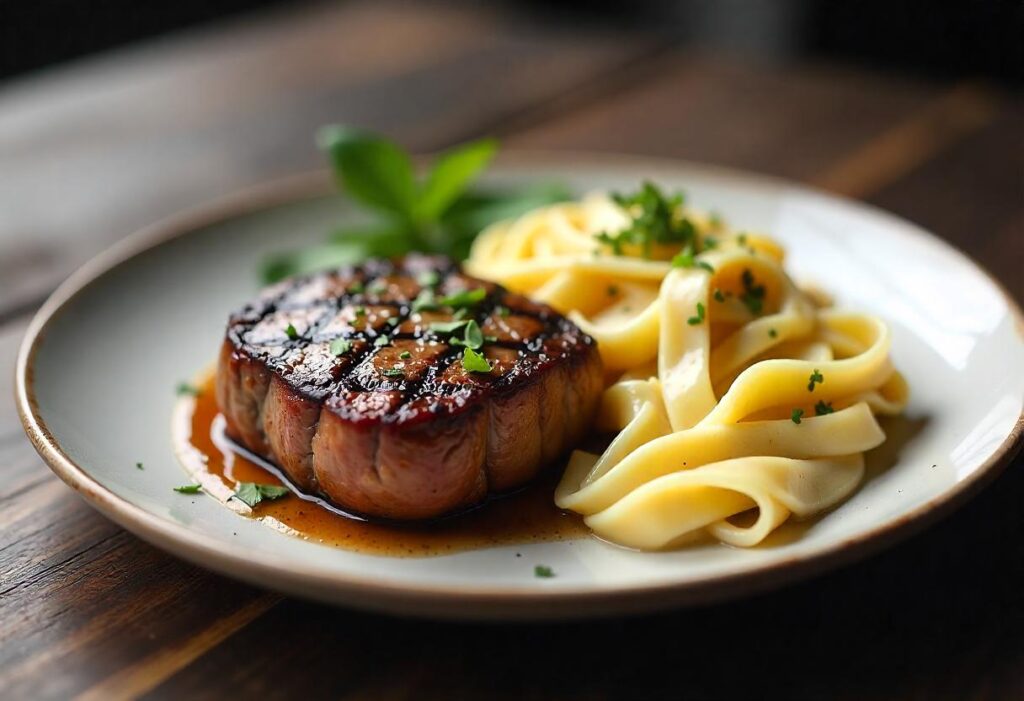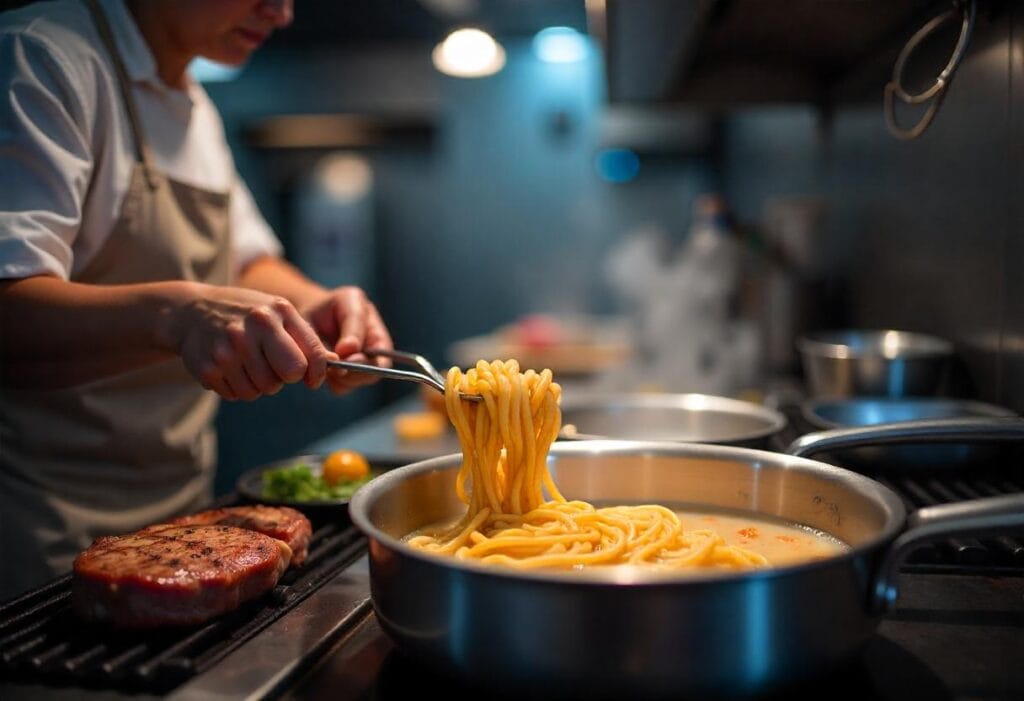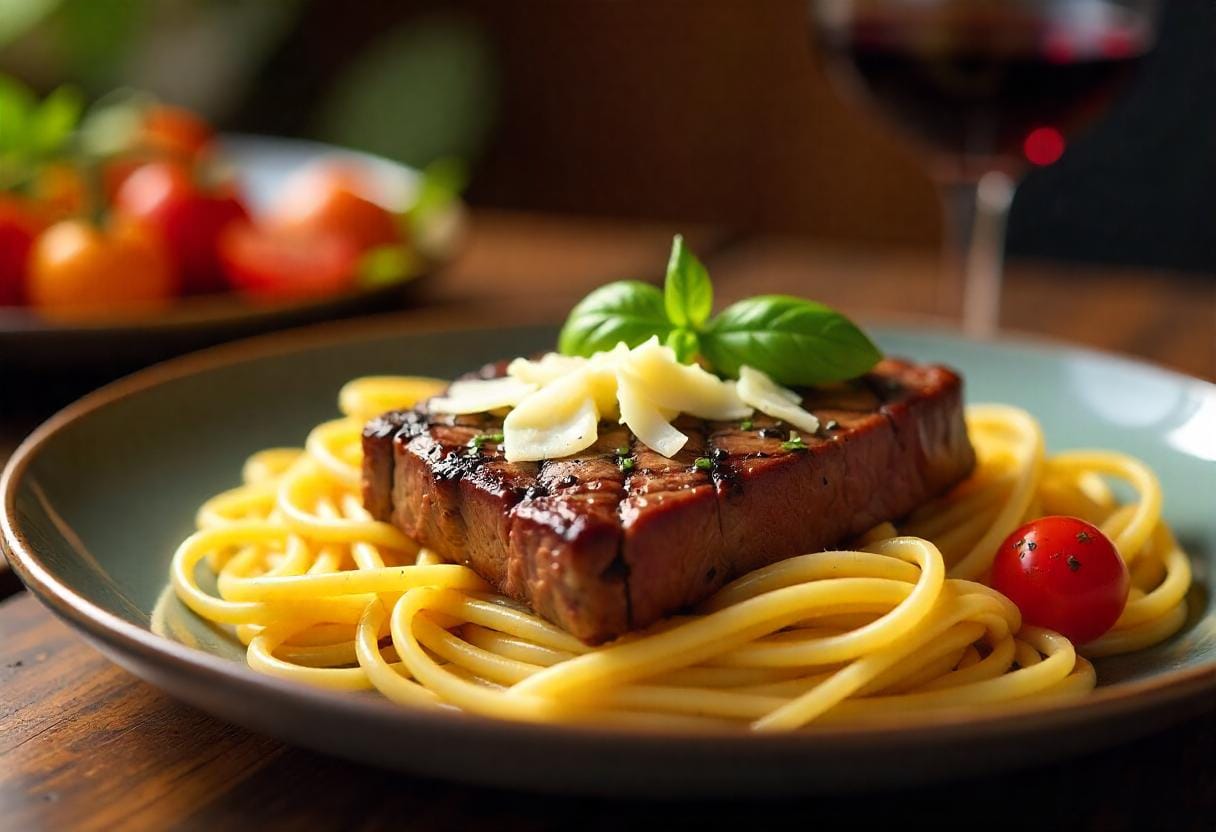Table of Contents
When you’re wondering what cut of steak is good for pasta, you’re aiming to elevate a classic dish into something extraordinary. The question of what cut of steak is good for pasta is essential for home chefs who want to impress. Whether you’re cooking for a weeknight dinner or preparing a special meal for friends or family, choosing the right cut of steak can make all the difference in ensuring your dish is as delicious as it can be
In this article, we’ll explore the best steak pasta combinations, tips on how to cook the perfect steak pasta, and creative variations that will keep you coming back for more. But first, let’s dive into why steak and noodles work so well together and how choosing the right cut makes the dish truly shine.

What Cut of Steak is Good for Pasta? Why It Makes All the Difference
When it comes to combining steak and pasta, the steak is the star of the show. The quality of the meat and the way it’s cooked can transform a simple dish into something memorable. Tender cuts with the right amount of marbling give you that perfect juicy steak that pairs beautifully with your noodles.
Imagine this: You’re cooking a plate of perfectly pan-seared steak and pairing it with a dish of tender spaghetti or fettuccine covered in a creamy or tomato-based sauce. The richness of the beef brings out the flavors of the pasta, and vice versa, creating a balance that makes each bite irresistible.
The cut of steak you choose determines the flavor profile and texture of the dish. You wouldn’t want to pair a tough cut of beef with delicate linguine, as the beef would overpower the pasta. On the other hand, a juicy, tender steak paired with hearty noodles will create a delicious balance of textures and flavors.
A Look at the Versatility of Steak and Noodles
One of the reasons why steak and pasta works so well together is its versatility. You can go from simple steak and spaghetti with a tomato sauce to a rich steak Alfredo with fettuccine. Whether you prefer a rich creamy sauce, tomato-based options, or just a drizzle of garlic butter, there’s no limit to the combinations that you can experiment with.
This pairing also allows for plenty of variations in terms of sauces and sides. Want a light, refreshing meal? Pair your steak with spaghetti and a tomato-basil sauce. Feeling indulgent? Go for a rich, creamy sauce like Alfredo and top it with grilled ribeye.
What’s exciting is how easily you can customize the dish to fit your personal tastes or the occasion. A family dinner might call for a hearty steak and penne combo, while a more elegant dinner might feature pan-seared filet mignon on a bed of fresh tagliatelle.

What Cut of Steak is Good for Pasta? Understanding the Basics
Factors to Consider When Choosing a Steak for Pasta
Choosing the right steak is crucial, so let’s dive into what cut of steak is good for pasta, focusing on factors like tenderness and fat content. When determining what cut of steak is good for pasta, you should evaluate several key elements. Here are the important factors to consider when making your selection:
- Tenderness: A steak that is too tough will make it difficult to enjoy, especially when paired with noodles. Tender cuts will melt in your mouth and pair beautifully with the texture of the pasta.
- Marbling: The fat running through the meat, also known as marbling, adds flavor and juiciness to your steak. Steaks with more marbling tend to be more flavorful, which is essential for creating a rich, satisfying meal.
- Cooking Method: The way you plan to cook the steak matters too. Some cuts, like filet mignon, are better suited for pan-searing or grilling, while others, like ribeye, are perfect for grilling to bring out their rich, beefy flavor.
- Flavor Profile: Think about how bold or mild you want the steak to be. Cuts like ribeye are known for their robust beef flavor, while filet mignon is milder but extremely tender. Both can pair excellently with a variety of pasta shapes and sauces.
The Role of Tenderness, Flavor, and Fat Content
When you choose a cut of steak for your pasta dish, consider how each aspect of the beef will enhance the overall dish:
- Tenderness: Cuts like filet mignon and sirloin are incredibly tender, making them ideal for slicing thinly and pairing with pasta. Tougher cuts like flank steak or skirt steak require a little more attention to cooking but can still shine when sliced properly and paired with the right sauce.
- Fat Content: Fat is essential for flavor. Steaks with higher marbling, such as ribeye or New York strip, bring a rich, juicy flavor that pairs wonderfully with creamy or garlic-based sauces. For lighter options, lean cuts like sirloin work well, especially when paired with tomato-based sauces.
What Cut of Steak is Good for Pasta? The Best Options
Now that we’ve covered the basics, let’s dive into the best cuts of beef for your steak and noodles dish. Each cut has its unique characteristics that make it perfect for pairing with different types of pasta and sauces.
Filet Mignon: A Tender, Mild Choice for Steak Pasta
When asking what cut of steak is good for pasta with delicate flavors, filet mignon is often considered the best choice, especially if you want a mild-flavored, tender piece of beef This cut is known for its exceptional tenderness and mild taste, making it the perfect option when paired with a rich, creamy sauce like Alfredo or garlic butter. Filet mignon works wonderfully with linguine or fettuccine, where its soft texture complements the smoothness of the noodles.
While it is on the pricier side, filet mignon offers a luxurious experience, making it ideal for special occasions or a more refined steak pasta dish.
Ribeye: Juicy, Flavorful, and Perfect for Hearty Pasta Dishes
For those wondering what cut of steak is good for pasta with bold flavors, ribeye is an excellent choice. Known for its marbling, ribeye steak is packed with juiciness and flavor, making it the perfect match for heavier pasta sauces, such as tomato-based marinara or cream-based Alfredo. Ribeye pairs exceptionally well with penne or rigatoni, where the richness of the beef can balance the thick, hearty sauces.
This cut is best grilled or pan-seared, allowing the fat to render and flavor the steak perfectly.
How to Cook Steak for Pasta
Grilling vs. Pan-Seared: Which Method is Best for Steak Pasta?
Both grilling and pan-searing bring out different qualities in the steak, and either method can be perfect for your steak and noodles dish.
- Grilling: This method works best for cuts like ribeye or sirloin. Grilling adds a smoky flavor that pairs wonderfully with tomato sauces and garlic butter sauces. The high heat seals in the juices while adding a crisp char to the meat.
- Pan-Seared: If you’re cooking filet mignon or New York strip, pan-searing is a great option. This method allows you to get a golden crust while keeping the inside tender and juicy. It’s perfect for richer, cream-based sauces that need a smooth texture.

Block Quote:
« The right cooking method brings out the best in each cut of steak, whether it’s the smoky char from grilling or the juicy tenderness from pan-searing. »
How to Cook Steak for Pasta
Perfecting the Doneness of Steak for Pasta
Regardless of what cut of steak is good for pasta, the key to a great dish is making sure the steak is cooked to perfection. Too often, we either overcook or undercook the beef, leading to a less-than-ideal result. So, how do we achieve that perfect balance?
- Medium-Rare: For a tender and juicy steak, aim for medium-rare. The steak will be pink in the center, slightly firm to the touch, and packed with flavor. For most cuts like ribeye or sirloin, medium-rare is ideal because it retains its moisture while still giving a slight char on the outside.
- Medium to Well-Done: Some people prefer their steak cooked a bit longer. If you’re aiming for medium or well-done, be cautious, as overcooking the steak can make it dry and tough. For steak pasta, aim to cook the steak at medium heat, letting the flavors develop without drying out the meat.
The key is using a meat thermometer. Aim for 130°F (54°C) for medium-rare, 140°F (60°C) for medium, and 160°F (71°C) for well-done. Always let the steak rest for 5–10 minutes after cooking to ensure the juices stay inside.
Slicing the Steak: How to Cut Steak for Pasta
Once your steak is cooked, the next step is to slice it properly. The way you slice your steak can make a huge difference in both texture and presentation. Here’s how to get it just right:
- Let the Steak Rest: After cooking, allow the steak to rest for a few minutes. This step helps redistribute the juices, ensuring the steak is tender and flavorful.
- Slice Against the Grain: Always slice against the grain of the meat. This means cutting perpendicular to the lines of muscle fibers. Slicing against the grain breaks down those fibers, making the steak easier to chew and giving you a tender bite.
- Thin, Even Slices: Slice the steak into thin, even strips to distribute the meat evenly throughout the dish. These slices will pair beautifully with your pasta, ensuring that each bite has the right balance of beef and noodles.
By following these tips, you’ll make sure your steak slices are tender, flavorful, and easy to enjoy with your favorite pasta.
Pairing Steak with the Right Type of Noodles
Choosing the right pasta to pair with steak is almost as important as choosing the right cut of beef. Each pasta shape and sauce creates a unique experience. So, what should you consider when choosing the right noodles?
Best Pasta Shapes for Steak: Penne, Fettuccine, and More
The shape and texture of your pasta play a significant role in how the dish will turn out. Different shapes work better with specific sauces and meats, so keep the following in mind:
- Penne: If you’re making a hearty, rich sauce (like Bolognese or cream sauce), penne is a great choice. Its sturdy, ridged texture allows it to hold onto thick sauces, and its hollow interior traps the sauce, making each bite flavorful.
- Fettuccine: If you’re opting for a creamy sauce like Alfredo, fettuccine is a classic choice. The wide, flat noodles allow the rich sauce to coat them perfectly, pairing beautifully with tender cuts of steak.
- Spaghetti: For lighter sauces like tomato-based marinara or a garlic oil drizzle, spaghetti is a versatile option. It’s easy to mix with steak slices, and its long strands work well with both cream-based and tomato-based sauces.
- Tagliatelle: If you’re making a more sophisticated dish, tagliatelle is an egg-based noodle with a luxurious texture. This pasta works wonderfully with tender cuts like filet mignon and pairs well with delicate sauces like garlic butter or light tomato sauce.
How to Choose Between Creamy or Tomato-Based Sauces
Now that you have your steak and pasta, the next question is, what kind of sauce should you use? Both creamy sauces and tomato-based sauces can work wonders with steak pasta, but the key is finding the right balance. Here’s what to consider:
- Creamy Sauces: Rich and indulgent, cream-based sauces like Alfredo or garlic butter pair beautifully with hearty cuts of beef like ribeye or filet mignon. These sauces complement the richness of the meat, offering a luxurious texture that coats both the steak and pasta perfectly.
- Tomato-Based Sauces: On the other hand, if you want something lighter and fresher, a tomato-based sauce like marinara or Pomodoro is an excellent choice. These sauces add a touch of acidity that cuts through the richness of the beef, creating a beautiful contrast in flavor. Steak and spaghetti in marinara, for example, is a classic combination.
Both sauces can work wonderfully, depending on your taste preferences and the steak cut you’re using.
Common Problems and Solutions When Making Steak Pasta
Overcooked or Undercooked Steak: Getting It Just Right
Cooking steak can be tricky, especially when it’s paired with pasta. Overcooking or undercooking the beef can affect the overall dish, leaving you with a dry steak or one that’s too tough to chew.
Solution:
- Use a meat thermometer to ensure that your steak reaches the right internal temperature. Medium-rare is usually ideal for steak pasta, giving you a tender and juicy cut.
- If the steak is undercooked, simply return it to the pan for a few more minutes.
Pro Tip: Always let your steak rest before slicing to lock in the juices and maintain tenderness.
Soggy Pasta: How to Prevent This Common Issue
There’s nothing worse than soggy noodles in a steak pasta dish. If your pasta has been sitting in the water too long, or if the sauce is too watery, you may find yourself with a disappointing meal.
Solution:
- Cook the pasta al dente—not too soft, not too firm. Check the pasta a minute or two before the package’s suggested cook time to make sure it’s still slightly firm.
- Reserve pasta water before draining to help adjust the sauce’s consistency.
- Toss the pasta with the sauce immediately after draining. Don’t let it sit in excess water.
Flavor Imbalance: Fixing Too Bland or Too Rich Steak Pasta
The balance between flavors is crucial when making steak pasta. If your dish is too bland, you might need to season the steak properly, and if it’s too rich, you can add a touch of acidity.
Solution:
- For Bland Flavor: If the steak or sauce lacks depth, try adding garlic, onion, herbs, or fresh lemon juice to bring in extra flavor. A sprinkle of Parmesan cheese on top can also enhance the overall taste.
- For Too Rich Flavor: Add a splash of white wine or a squeeze of lemon juice to brighten up the dish. Fresh basil or parsley can also help cut through the richness.
Creative Variations of Steak Pasta
If you’re looking to add some excitement to your dish, consider creative ways to elevate your pasta. Whether it’s a garlic butter steak pasta or a hearty tomato-based version, there’s no shortage of ways to make your dish stand out.
Garlic Butter Steak Pasta: A Simple Yet Delicious Option
For a quick and easy steak pasta, you can’t go wrong with garlic butter. The richness of the butter combined with the garlic’s aroma pairs perfectly with tender steak slices and your favorite noodles. This variation is a crowd-pleaser that’s perfect for any weeknight meal.
Solution:
- Sauté garlic in butter, add the steak slices, and toss everything with pasta for an indulgent, savory dish.
Tomato and Steak Pasta: Combining Richness with Freshness
If you love the freshness of tomatoes, try a tomato-based sauce with your steak. The acidity of the tomatoes balances out the rich beef, making it a lighter, yet still satisfying, meal.
Solution:
- Make a marinara sauce from fresh tomatoes, garlic, and basil to pair with your steak and pasta. Add a touch of olive oil to bring everything together.
Steak Alfredo: Creamy, Hearty, and Full of Flavor
For a rich and creamy experience, pair your steak with Alfredo sauce. The silky smoothness of the sauce envelops the steak slices and the pasta, creating a delicious, indulgent dish that’s perfect for special occasions.
Solution:
- Combine heavy cream, Parmesan, and butter to create the perfect Alfredo sauce. Add in the sliced steak, and serve with fettuccine or penne for a hearty meal.
Block Quote:
« When pairing steak with pasta, it’s important to focus on balance—tender, juicy meat with the right noodles and sauce will elevate your meal. »

